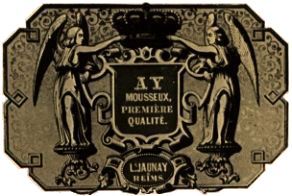Families:
Beasley
Cawley
Fisher
Gilmour
Jaunay
Howell ancestry
Jacquesson branch
Krug branch
Viard ancestry
Puttick
Sharp
Smith
Newsletter Articles
Distribution (FRA)
Distribution (AUS/NZ)
Known Jaunays.
Photo album
Home
Graham's AUS research
Contact Graham
|
A small marque
The story of Louis Brunet Jaunay 2
Louis Brunet and Annie had three sons. Annie was determined that her first born would share her Scots/Irish heritage and so arranged to be in Ireland for the birth of Frank Cunningham on 22 June 1851. Frank's second name, Cunningham being Annie's mother's maiden name. Julius Gilmour was born at Upper Clapton, London on 30 June 1852. The third son, Arthur Henry Howell was born on 10 August 1853 at Reims but died six months later and was buried the the newly acquired family grave at the North Cemetery, Reims.
The label, L Jaunay & Co was not established until late in Louis' life but he was trading in wines before Joseph Krug broke away from Jacquesson et Fils in 1842. In fact products for L Jaunay were manufactured by Krug. The wines were bottled at Reims using grapes from vineyards at Aÿ and blended the local wines of that district. One very French product for the local market produced by Louis but in fact made by Krug was Tisane de Champagne.

Louis Brunet was also something of an inventor and developed a new corking machine whose principles are still used in the process today.
Like his brother-in-law, Joseph Krug, Louis Brunet Jaunay eventually prospered and was able to give his two sons an excellent education. Unfortunately as a result they showed little interest in learning the finer detail of the highly competitive champagne blending and manufacturing process. Their father also refused to allow his sons a management place in the company until they married. This strange attitude was not enforced to encourage an early marriage, but rather a desire for his sons to receive a wide experience before settling down in Reims. Unfortunately this vision or as it turned out, oversight, was to be the eventual undoing of L Jaunay & Co.
As a further testimony to his affluence, and a recognition of his mother, Louis Brunet arranged to hang a gilt framed portrait of Ann in the dining room of the his residence in Reims. Ironically this painting's destiny would parallel that of the family! The bullet hole inflicted by a Prussian soldier during the Franco-Prussian War in 1870 was not repaired. This painting passed on to the Krug family when the last of the Jaunays left France. It was destroyed in a German bombardment of Reims in World War I.
His holdings at Aÿ should have given Louis Brunet an outstanding source of top quality grapes independent of the vignerons. In normal business practice this would have been considered a very astute, if unchampagne like, move. Unfortunately this investment was also to play a role in the demise of L Jaunay & Co. as the disease, phylloxera, had arrived on the scene from California and was threatening to devastate the vineyards of Champagne in the late 1880s. Strangely enough the phylloxera blight did not arrive until late in the century but the vineyards had to cope with a new disease which arrived courtesy of the phylloxera free vines from the United States. Planosphora viticola, or plain mildew was imported with the new stock and reached the Champagne area in 1885 and while not as devastating as phylloxera was to be, it certainly took its toll on the growers of the day.
Continued...
|
|